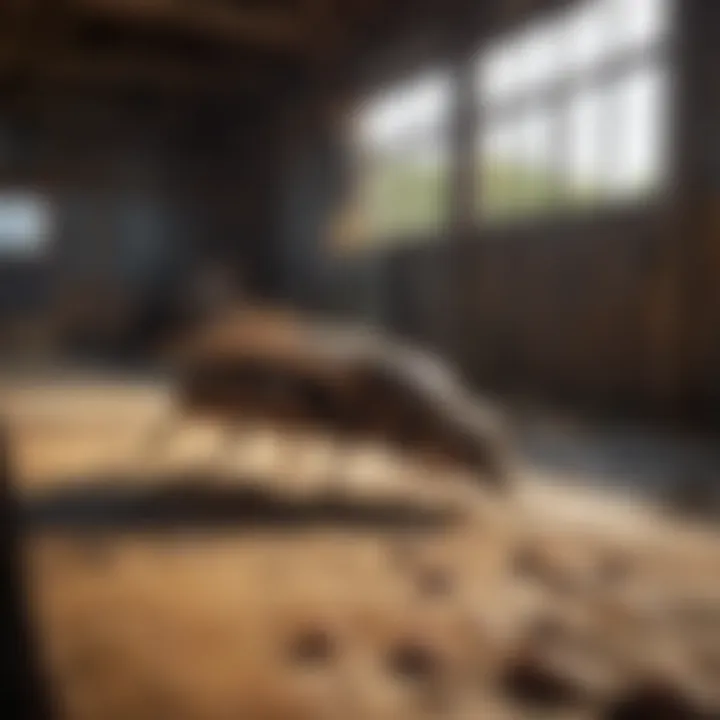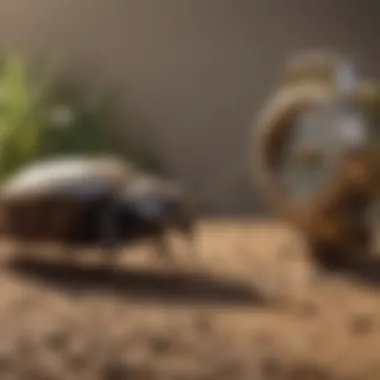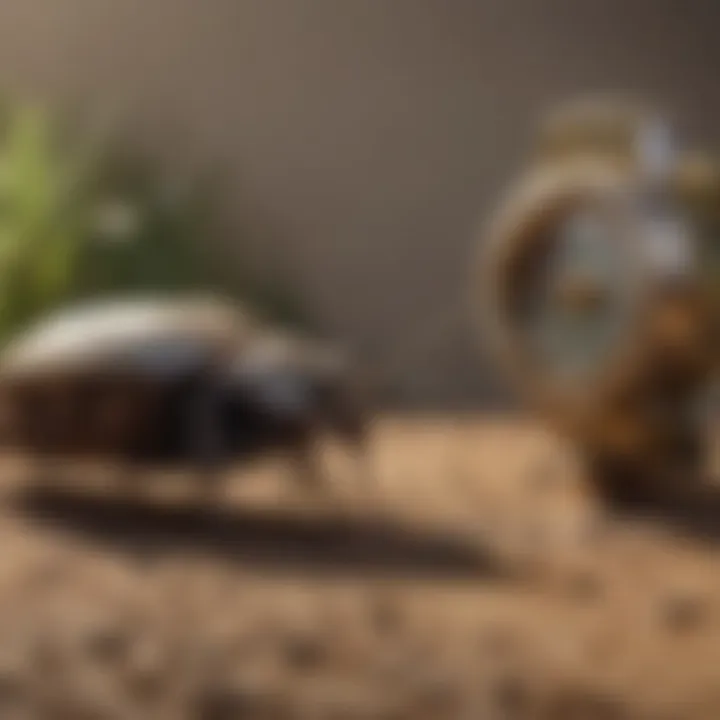Comprehensive Guide to Barnes Pest Control Practices


Intro
Navigating the world of barn management presents its own unique set of challenges, particularly when it comes to pest control. Understanding pest behavior, impact, and control techniques is essential for ensuring that both the structure of the barn and the health of its inhabitants—be it livestock or storage—are well-preserved. In this article, we delve deep into the complexities of pest control specific to barn environments, shedding light on the various types of pests that often take up residence in these wooden havens and exploring methods to manage and mitigate the issues they cause.
Understanding Pests
Definition of Pests
Pests are generally organisms that have a detrimental effect on human endeavors, especially agriculture and animal husbandry. Within a barn setting, pests can range from insects like flies and beetles to rodents such as mice and rats. Each of these pests not only poses a risk to stored feed and equipment but can also threaten the health of barn animals.
Importance of Pest Identification
Identifying pests accurately is the starting point for effective control. For instance, a barn plagued by rats may hear distinctive scratching sounds, while signs of a fly infestation might include unusual buzzings or the presence of larvae around feed areas. Knowing what you’re dealing with helps tailor your approach to control.
"An ounce of prevention is worth a pound of cure.” – Benjamin Franklin
By recognizing infestation signs early on, barn owners can implement timely measures to prevent further repercussions.
Prevention Techniques
Home and Garden Preventative Measures
Adopting preventative measures is crucial in maintaining a pest-free barn environment. Here are some effective strategies:
- Maintain cleanliness: Keep feed areas clean and avoid spills. Regularly clean out stalls and bedding to minimize attractants.
- Secure storage: Invest in rodent-proof storage containers for feed to ensure that pest access is limited.
- Seal entry points: Check for cracks or holes in barn structures and seal them tightly to keep unwanted visitors out.
Seasonal Prevention Tips
Different pests are more prevalent in specific seasons, necessitating tailored prevention measures. During warmer months, expect an influx of flies and beetles; routinely inspecting and cleaning barn areas can keep these pests at bay. As winter approaches, mice may seek warmth, hence it’s crucial to inspect and reinforce structural integrity before the cold sets in.
Eco-Friendly Pest Control Solutions
Overview of Sustainable Practices
In recent years, there's been a shift towards more sustainable pest control practices. These practices emphasize ecological well-being without compromising pest management. Techniques might include introducing natural predators to pest populations or implementing habitat modifications that discourage infestations.
Natural Remedies and Their Effectiveness
When it comes to dealing with pests, natural remedies can offer viable solutions without the harsh chemicals associated with traditional pest control methods. Some recommended remedies include:
- Diatomaceous earth: This natural powder works by dehydrating insects that crawl over it, effectively handling crawlers like ants and cockroaches.
- Essential oils: Oils such as peppermint and lavender can repel specific insects when used as sprays around barn entrances.
- Traps: Using simple traps crafted from household items can be an effective way to manage small rodent populations.
Understanding and employing these strategies can dramatically improve not only the barn's ecosystem but also enhance the quality of life for both animals and humans alike.
Understanding Barnes Pest Dynamics
Understanding the dynamics of pests within barn environments is crucial not only for maintaining a safe and healthy setting but also for ensuring the longevity of barn structures and the well-being of the animals and products housed within them. Pests interact with their environment in ways that can either disrupt or facilitate ecosystem function. By grasping how these pests function, their behaviors, and their ecological roles, barn owners can develop more effective management strategies that benefit both their operations and the environment.
Importantly, understanding these dynamics helps in implementing targeted control measures instead of relying on blanket treatments that can harm non-target species and disrupt the barn's ecosystem. Moreover, it cultivates a proactive approach towards pest management, allowing barn owners to anticipate infestations rather than simply react to them.
The Ecology of Pests in Barn Environments
Pests in barns are not just nuisances but part of a complex ecological tapestry. They can often be indicators of specific environmental conditions. For instance, the presence of particular insect species might signal high moisture levels, which could lead to other more serious issues. Understanding the root ecology of these species can empower barn owners to create conditions that discourage pest establishment while promoting a healthier environment for their animals.
Common Pests Found in Barns
Rodents
Rodents are among the most frequent pests that barn owners encounter, and for good reason. They are highly adaptable, meaning they can thrive in diverse environments—including barns. One key characteristic of rodents is their reproductive capability; a couple of mice can turn into a sizable population in a matter of months. This rapid reproductive rate makes understanding rodent behavior essential for effective pest control.
While they are often viewed negatively, rodents can also serve as indicators of certain environmental conditions. However, their presence typically leads to negative outcomes like structural damage and health risks, which is why ongoing monitoring and control strategies, such as trapping or baiting, are necessary.
Insects
Insects, too, represent a significant category of barn pests. From pantry pests like weevils to structural pests such as termites, their diversity and numbers can become overwhelming. A defining aspect of insects is their role in ecosystems as decomposers, which can be beneficial in some contexts. Still, when their populations surge uncontrolled, they pose threats not just to barn integrity but to the health of livestock and stored products. Integrating pest control practices tailored specifically for insects is vital in creating a balanced approach towards managing them.
Birds
Birds may initially seem less concerning, but certain species can become pests in barn settings. For instance, barn swallows can create a mess with their droppings, impacting cleanliness and hygiene. One notable characteristic of birds is that they can lead to diseases spreading quickly among areas where food is stored. Their opportunism in scavenging for food places them in close proximity to livestock, which is a concern for any barn owner. Recognizing bird patterns and control options, like netting, can mitigate the disruption caused by these winged visitors.
The Impact of Pests on Barns


Structural Damage
Structural damage is one of the more severe impacts pests can have on barns. Rodents, for example, gnaw on wood, wiring, and insulation, which can compromise safety and efficiency. Not only does this lead to costly repairs, but recurring damage can significantly affect barn operations. It's crucial to notice early signs of damage, to prevent escalating repair needs in the future.
Health Risks
Health risks associated with pests are a major concern. Pests like rodents and insects can carry diseases that threaten livestock and even humans. For example, specific diseases can be transmitted through droppings, creating a health hazard that barn owners can’t ignore. Being on the lookout for pest signs is pivotal in minimizing health risks to both human caretakers and animals.
Product Contamination
Lastly, product contamination is an often-overlooked aspect of pest impacts. Whether it’s grain supplies or animal feed, pests can lead to contamination that renders products unfit for consumption. For barn owners, safeguarding against contamination requires diligent practices, such as securing food storage and regularly checking for pest activity. Protecting stored goods not only saves money but also ensures that livestock receive the best feed.
"In barns where pests are prevalent, a single overlooked corner can lead to cascading consequences—safety, health, and financial stability at stake."
In summary, understanding the dynamics of pests within barn environments helps in adopting more precise and effective control measures. It also underscores the interconnectedness of the barn ecosystem and the importance of a proactive, informed approach to pest management.
Identification of Pests
Identifying pests in barn environments is like solving a mystery where each clue leads to better management decisions. Recognizing the specific pests that inhabit barns helps in implementing effective control measures, thereby reducing damage and ensuring healthier environments for livestock and crops. Understanding pest types and their behaviors allows barn owners to tailor their management strategies to suit their unique challenges.
Moreover, effective pest identification minimizes the risk of prolonged infestations that can lead to health risks for animals and humans alike. Early detection is key; once pests are spotted, the appropriate response can be executed swiftly, reducing the need for invasive interventions later on. This section sheds light on visual identification techniques and other telltale signs of infestations, which are critical components in effective pest management.
Visual Identification Techniques
When it comes to spotting pests in a barn, the eyes can be both your best asset and your biggest downfall. Familiarizing oneself with pest appearances can significantly enhance management efforts. Some pests hide out of sight, while others are overtly noticeable, each rendering different challenges in pest management. For example, distinguishing between a field mouse and a house mouse can hinge on size and tail length; the former sports a longer and more slender tail compared to its domestic counterpart.
Utilizing field guides or reliable digital resources can help barn owners gain better insights into the characteristics of specific pests. Setting up routine inspections, particularly in nooks, crannies, and places known to harbor infestations, has proven useful. The more you know about their physical traits, the more empowered you are to act swiftly in the face of an infestation.
Signs of Infestation
Recognizing signs of infestation can be akin to following footprints in the sand. The evidence might not always be glaring, but if you know what to look for, you’ll find your way to the source. Here are some key indicators:
Tracks and Droppings
Perhaps the most straightforward indicators of a pest problem are tracks and droppings. Rodent droppings, for example, typically resemble small, dark grains of rice. These tiny tell-tale signs help locate nesting sites and can indicate how severe an infestation might be. Tracking these droppings is beneficial because it helps to establish how long pests have invaded your barn.
Furthermore, the location of droppings can hint at pest pathways, helping barn owners to identify high-traffic areas that may require more frequent monitoring or strategic interventions. A quick examination can reveal whether the need for pest control is urgent or can wait for another day. It’s like having a roadmap to address the situation effectively.
Nesting Materials
Nesting materials also give significant clues about pest presence. Signs such as shredded paper, pieces of insulation, or even straws scattered in corners may indicate nesting by rodents or birds. Agricultural debris can often be repurposed, which makes it appealing to pests looking for shelter. By understanding the characteristics of nesting materials, such as their composition and arrangement, barn owners can easily ascertain what type of pest they are dealing with and how to intervene accordingly. This information equips them to respond in ways that are both effective and cautious, reducing disturbances to the barn's ecosystem.
Damage to Surfaces
The condition of surfaces around the barn can tell tales of pest activity that might otherwise go unnoticed. Gnaw marks on beams, bite marks on stored feed, or holes in silos can all signal unwanted guests at work. By paying attention to such surface damage patterns, barn owners can identify which pests may be present.
For instance, a rodent problem often reveals itself through wood shavings or frayed materials. Understanding this connection is crucial because it not only helps with immediate pest identification but also allows barn managers to develop preventative solutions for the future. Addressing damaged areas can reduce nesting opportunities, thus clamping down on potential re-infestations.
Effective pest identification sets the foundation for successful management; without knowing your foe, you can’t prepare your defenses.
Preventative Measures
Preventative measures are the backbone of pest control in barn settings. Taking proactive steps can mean the difference between a thriving barn and one overrun by unwanted pests. These measures not only minimize the risk of infestations but also protect the health of livestock and the integrity of the barn itself. By understanding and implementing practical strategies, barn owners can effectively reduce the chances of pests making their home in these spaces. Just like an ounce of prevention is worth a pound of cure, investing effort upfront can lead to significant long-term benefits.
Physical Barriers and Exclusions
Creating physical barriers and exclusions is a key strategy in pest prevention. Installing screens on windows, sealing cracks in walls, and using mesh fabrics on vents can drastically reduce the entrance points for pests. It is like putting on a lock to safeguard your valuables; without it, intruders can come and go as they please.
Key characteristics of physical barriers include:
- Durable materials that withstand wear and tear.
- Strategic placement to cover common entry points like doors and windows.
Using a combination of techniques can bolster the effectiveness of these barriers. The more thorough the exclusions, the less likely pests are to find a way in. However, it is crucial to regularly inspect these barriers for any damages or vulnerabilities since they can degrade over time.
Sanitation Practices
Good sanitation practices lay the groundwork for effective pest control. Maintaining cleanliness within a barn is not just about aesthetics; it helps in minimizing pest attraction. Just think of it this way: a clean barn is less appealing to pests than one with food scraps and waste lingering about.
Regular Cleaning Protocols
Regular cleaning protocols are essential to ensure that barns remain pest-free. This includes sweeping and mopping floors, cleaning feed storage areas, and regularly checking stalls. The aim is to create an environment that is not conducive to pests.


Why is this aspect so important?
- Reduces Food Sources: Keeping feed areas clean eliminates crumbs that pests thrive on.
- Encourages Early Detection: Regular cleaning helps in spotting early signs of pest problems before they escalate.
Additionally, a unique feature of sticking to regular cleaning protocols is the creation of a sustainable habit. It’s about developing a routine that fosters a culture of cleanliness. Barns that fall into a regular cleaning schedule see a marked decline in pest populations and thus benefit from healthier livestock.
Proper Waste Management
Proper waste management is another pillar of effective pest control in barns. This involves timely disposal of manure, grain spills, and general waste. An organized approach to waste can make a huge difference.
Key characteristics of proper waste management include:
- Designated disposal areas that are kept away from the main barn.
- Regular schedules for waste removal.
The unique feature of this practice is how it integrates seamlessly into the overall management of the barn. Long-term waste management can lead to a more hygienic environment, making pests less likely to call your barn home. Convenience is always a plus; there's simply less maintainance to do when waste is removed regularly.
In summary, the importance of preventative measures, particularly in terms of physical barriers and sanitation practices, cannot be overstated. These actions lead to a visible decline in pest activity, ultimately ensuring the longevity and functionality of barn environments. With the right strategies in place, barn owners can uphold a harmonious balance between their livestock and the surrounding ecosystem.
Integrated Pest Management Approaches
Integrated Pest Management (IPM) is a holistic approach that acknowledges the complex interactions between pests, humans, and the environment. It aims to minimize pest populations through a combination of strategies that are sustainable, economical, and safe. The significance of IPM in barn environments can hardly be overstated; it fosters a balance, ensuring that pest control efforts do not unintentionally harm the very ecosystems they aim to protect.
When implemented correctly, IPM can effectively reduce reliance on chemical pesticides, leading to lower risks for humans, livestock, and beneficial organisms. By understanding pest biology and behavior, barn owners can make informed decisions, allowing them to target interventions when and where they will be most effective.
Biological Control Methods
Biological control methods leverage natural enemies of pests, such as predators, parasitoids, or pathogens. This approach offers a way to keep pest populations in check without the use of toxic chemicals. For example, introducing a population of ladybugs in barns can help manage aphid infestations effectively, as ladybugs are voracious consumers of these pests.
The beauty of biological control lies in its sustainability. While it may require an upfront investment like bringing in beneficial insects, the long-term benefits far outweigh the costs. Besides, this method fosters ecological balance by encouraging the presence of beneficial species, which contribute to barn health in various ways.
Chemical Control Strategies
When all else fails, chemical control strategies can be employed. However, it’s crucial to do this judiciously.
Targeted Pesticides
Targeted pesticides are a specific type of chemical control that seeks to minimize environmental impact. Unlike broad-spectrum pesticides, which kill a wide range of insects regardless of their benefits or harm, targeted pesticides focus on particular pests. This characteristic makes them a valuable option in an IPM approach.
What sets targeted pesticides apart is their precision. They feature compounds designed to disrupt the life cycle of certain pests, making them a popular choice. Nonetheless, one has to consider the potential resistance these pests may develop over time, which can diminish the efficacy of these controls.
Application Techniques
The right application techniques can amplify the effectiveness of chemical control strategies. Proper timing, equipment, and methods of application can make a dramatic difference in outcomes. For instance, using fine mists can reduce pesticide drift, ensuring that the chemical reaches the target pests without affecting non-target organisms or polluting surrounding areas.
Cultural Practices for Pest Management
Cultural practices focus on altering the environment to make it less hospitable for pests. This might include rotating crops, maintaining cleanliness, and managing water sources. Such practices not only deter pests but also enhance the overall productivity of the barn environment.
Maintaining good ventilation, for instance, can help to limit the humidity that many pests thrive in. Ensuring that feed is stored properly can prevent rodent infestations and mold growth, providing a healthier environment for both animals and crops.
Overall, the tailored application of integrated pest management concepts in barn settings leads to robust and resilient ecosystems that benefit all inhabitants.
Sustainable Pest Control Practices
Sustainable pest control practices are becoming increasingly crucial in the modern barn environment. Not only do they address the immediate concerns of pest infestations, but they also promote long-term ecological balance. Implementing these practices means considering the wider impact of pest control strategies on the ecosystem.
Utilizing sustainable methods helps minimize the risks related to chemical output, fostering a healthier environment for both the animals and the humans who work in or around barns. In essence, it’s all about finding a balance between effective pest management and protecting our precious ecosystems. Here are some specific benefits and considerations:
- Environmental Health: Sustainable practices reduce harmful chemicals in the barn and surrounding areas. This leads to healthier soil and waterways, promoting biodiversity.
- Economic Sustainability: While some may think that eco-friendly methods come at a higher cost, in the long run, they often lead to savings. Improved pest-resistant crops or livestock can result in less money spent on pesticides.
- Regulatory Compliance: Following sustainable pest control practices can help barn owners stay aligned with increasingly stringent environmental regulations, reducing potential liabilities.
By prioritizing sustainability, barn owners can protect not just their properties but also the larger environment they inhabit.
Eco-Friendly Alternatives
When it comes to pest control, there are numerous eco-friendly alternatives available. One effective approach is to use natural repellents derived from plants. Essential oils like peppermint or cedarwood can deter pests without introducing toxic chemicals into the barn. Additionally, physical traps can be quite successful for rodents without harming the environment.
It's wise to integrate organic composting as a pest deterrent. A thriving compost pile attracts beneficial organisms which help in controlling pests naturally.
Here are some more eco-friendly alternative methods:
- Plant Companions: Use plants that naturally repel pests. For example, marigolds can deter nematodes and mosquitoes.
- Beneficial Insects: Introducing predators like ladybugs can help control aphid populations without chemical interventions.
- Natural Barriers: Floating row covers can serve as a shield against flying pests, allowing for healthy crop growth.


Impact of Chemical Use on Biodiversity
Chemical pest control can have detrimental effects on biodiversity. In barns, the application of synthetic pesticides can lead to various environmental problems. These chemicals do not just target intended pests; they can inadvertently affect non-target species, including pollinators crucial for maintaining healthy ecosystems.
The death of beneficial insects can create an imbalance, making it harder for natural pest control methods to work efficiently. Moreover, the runoff from barn applications can contaminate local waterways, harming aquatic life and leading to a decrease in overall biodiversity.
To truly appreciate the impact of chemicals, consider this:
"The over-reliance on chemical pest control is like inviting a wolf into the henhouse. Initially, it may solve a problem but ultimately leads to far greater consequences."
Choice of method empowers barn owners to seek integrated approaches enhancing not just their immediate surroundings but also contributing positively to the grander scheme of biodiversity protection. Choosing sustainable methods is not just a trend; it’s a vital practice that cultivates a healthier environment for everyone.
Monitoring and Evaluation
The realm of pest control in barns is not a one-time endeavor; it requires ongoing attention and a structured approach to both monitor and evaluate interventions. This process is crucial for ensuring the effectiveness of pest management strategies and adapting them based on real-time observations.
Monitoring involves continuously observing pest populations, their behavior, and the environmental factors that contribute to their presence. This practice helps in identifying potential threats before they escalate into significant problems. Regular assessments can save barn owners from costly damages and health risks associated with pest infestations.
Evaluating the outcomes of these monitoring efforts allows barn owners to understand which methods are working and which might need tweaking. By analyzing data, decisions can be made not just reactively, but proactively, setting the stage for sustainable pest control.
Establishing Monitoring Protocols
Successful pest management starts with well-structured monitoring protocols. These serve as the groundwork for all subsequent actions.
- Define Objective Indicators: Clearly define what you need to monitor. This may include noting the types of pests, their numbers, and their locations within the barn.
- Set a Schedule: It’s essential to regularly inspect the barn. Weekly checks might be effective, or even daily during peak pest seasons. By sticking to a schedule, you make it easier to spot issues early.
- Utilize Tools: Employing traps and sensors can enhance these protocols. For instance, sticky traps can indicate pest activity levels, while moisture sensors can help identify areas that are prone to pest intrusion.
- Keep Records: Thorough documentation is key. Tracking observations over time can provide insights into patterns, helping predict future infestations.
- Engage the Team: Train everyone involved in barn maintenance about the importance of monitoring. Everyone should be able to recognize signs of pests and report findings promptly.
By establishing detailed monitoring protocols, you turn potential pest threats into manageable situations.
Assessing Control Effectiveness
Once pests are monitored, it’s vital to assess how effective your control measures have been. Without this evaluation, you could end up throwing good money after bad, sticking with methods that just don’t cut it.
- Data Analysis: Look at the data collected from your monitoring efforts. Have pest numbers decreased? Are the traps showing fewer catches? This numerical assessment will inform you whether your interventions are working.
- Reviewnon-Target Effects: It’s important to check if the control methods used are affecting other organisms in your barn. If beneficial insects or other wildlife are being impacted, a shift in strategies may be necessary.
- Feedback Loop: Create a feedback mechanism to continually improve your strategies. Regularly discuss findings with all team members involved in pest management.
- Adjust Strategies: Don’t be afraid to change your approach if something isn’t working. If one method hasn’t yielded results over a certain time frame, explore alternatives.
Effective pest control relies not just on immediate actions but also on ongoing evaluation to inform future practices.
Engaging in consistent monitoring and evaluation ensures you are equipped with the knowledge necessary to adapt your pest management strategies, effectively safeguarding your barn against unwanted intruders.
Future Trends in Pest Control
As we continue to face the challenges of pest management in barns, understanding future trends in pest control has become essential. Keeping our barns pest-free is not just a matter of convenience; it's pivotal for health, safety, and sustainability. This evolution stems from the need to balance efficiency and ecological concerns while embracing advancements in technology and research. Here, we’ll delve into technological innovations and research directions in entomology that are poised to shape the future of pest control.
Technological Innovations
The marriage of technology and pest control is becoming increasingly apparent, offering innovative solutions that were once the stuff of science fiction. One promising trend is the rise of smart traps and monitoring systems. These systems utilize sensors and IoT (Internet of Things) to provide real-time data about pest activities. For instance, a smart trap tailored for mice can send alerts to farmers' smartphones whenever it catches an intruder, enabling swift action before a small issue becomes a bigger hassle.
Furthermore, drone technology is emerging as a game-changer in pest management. These flying devices can cover vast areas quickly, identifying pest infestations from above, which is particularly advantageous for larger barn settings. They can also be used to disperse eco-friendly pesticides in target areas, minimizing waste and exposure to non-target species and humans.
Some innovations also delve into genetic engineering, focusing on developing pest-resistant crops. These advancements not only help manage pest populations but can also significantly reduce the reliance on chemical pesticides. The benefits are two-fold, as it enhances food security and lessens the environmental footprint associated with conventional pest control methods.
Research Directions in Entomology
The field of entomology is also witnessing significant shifts, with research becoming more specialized and targeted. One key area being explored is the study of pest behavior. Understanding how pests interact with their environment allows for developing more effective control methods that account for their habits and life cycles. For example, researchers are investigating the mating strategies of certain pest species to disrupt their reproductive cycles effectively.
Moreover, the focus is on exploring natural predators and biocontrol agents that can serve as allies in the fight against pests. Through robust research, scientists work to identify specific species that can control pest populations without harming the ecosystem. The integration of biological control methods can be an elegant solution that provides control while maintaining the biodiversity essential for a healthy barn environment.
"The future of pest management relies heavily on our ability to adapt and embrace new technologies while ensuring we’re protecting our ecosystems."
As we look ahead, the intersection of technology and research heralds a new era in pest control. By leveraging these advancements, barn owners can maximize efficiency while promoting ecological balance. It’s a delicate dance between managing pest populations and maintaining harmonious farm life. As we continue to learn and evolve, the future of barn pest management appears promising, blending tradition with innovation.
The End
Understanding pest control in barn environments is not just a matter of maintaining aesthetics or comfort; it extends deeply into the realms of health, safety, and the very sustainability of agricultural practices. It's crucial for barn owners to recognize the implications pests can have, not only on the structural integrity of buildings and equipment but also on the well-being of both animals and humans who interact with these spaces.
Effective pest control strategies, as discussed in this article, should be viewed as a holistic approach. It is essential to combine prevention, identification, and management techniques in a cohesive manner. Methods and systems that are environmentally aware must take precedence; thus, this isn't merely about exclusion but also about inviting a balance within the ecosystem of the barn. By employing Integrated Pest Management (IPM) principles, barn owners can mitigate risks while ensuring that they are not compromising the well-being of surrounding wildlife and agricultural biodiversity.
Another key take away is how the advancements in technology, highlighted throughout the article, play an important role in improving effectiveness. New innovations allow for more precise application of chemicals and better monitoring of pests, which can reduce overall costs and enhance outcomes. Recognizing the cultural and behavioral habits of pests is equally important, guiding the development of sustainable practices that align with the dynamic nature of the barn's environment.
The importance of thoughtful, informed pest management cannot be over-emphasized. It is not only about eradication but also about fostering an ecosystem that is healthy for every living being involved.
With the many tools and methods available, barn owners can craft their own best practices tailored to their unique circumstances. Observing the balance between effective pest control and environmental stewardship will be a recurring theme that stands out from this exploration.
Key Takeaways for Effective Pest Management
- Recognize Early Signs: Monitoring and recognizing signs of pests early can save time and resources.
- Regular Inspections: Frequent check-ups of barn structures can help spot vulnerabilities that pests exploit.
- Sustainability First: Emphasizing eco-friendly practices helps protect not only the barn’s integrity but also the broader environment.
- Use Integrated Methods: Applying multiple approaches ensures a comprehensive response to pest issues.
- Educate and Train: Keeping all staff informed about pest management practices can create a unified front against infestations.
Ultimately, by internalizing these principles and adjusting management practices as new information and technology are developed, barn owners can create a pest control strategy that is effective, sustainable, and adaptive to future challenges.



